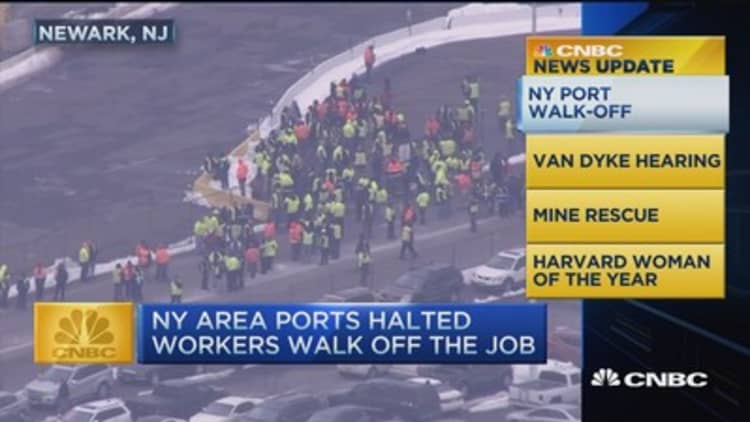Business at the nation's leading container ports is picking up, perhaps a sign the general economy may be in better shape than some suggest.
As a group, loaded container volumes at the nation's top 10 ports notched a 14 percent increase in January 2016, compared with the year-ago period, according to figures compiled by Bank of America Merrill Lynch. Also, port data for February look encouraging and cargo rail traffic volume grew slightly last month.
"No doubt we have definitely seen things bouncing off the worst," said Ken Hoexter, a transportation analyst at Bank of America Merrill Lynch. "The exciting part is there's still growth overall when we normalize for that port strike."
The strong dollar helped drive imports sharply higher at the Los Angeles and Long Beach ports, and the two delivered their busiest February volumes ever. Together, the two Southern California ports make up about a third of all cargo traffic imported into U.S. ports and are sometimes considered a predictive indicator of the economy.
"March is expected to be strong," said Port of Long Beach CEO Jon Slangerup, although cautioning that it will look negative compared to the year-over-year volumes because "March 2015 was a recovery month. It's shaping up to be a very strong first quarter relative to our history."
At the Port of LA, total container volume was up by 42 percent in February 2016 over the like period a year earlier, while Long Beach — the country's No. 2 seaport after LA — grew volume by about 36 percent during the same stretch. Container cargo imports at both complexes rose by more than 40 percent in February from the prior year, while container cargo exports in the same period grew at double-digit rates.
Granted, LA and Long Beach port volumes from February 2015 were unusually weak due to the U.S. West Coast port labor dispute, severe congestion and goods getting diverted elsewhere. But even so, when comparing LA's container volumes in February 2016 to more normalized volume levels recorded in February 2014 (before the labor strife), it reveals that imports rose more than 30 percent and exports fell less than 1 percent.
The volumes for February 2016 benefited as U.S. importers stepped up shipments of apparel, footwear, electronics and home products ahead of the Chinese New Year holiday, which began Feb. 8.

"I am very encouraged by the start to the year," said Port of Los Angeles Executive Director Gene Seroka. "What it is showing is that here is continued movement forward in the U.S. economy."
Elsewhere, the Port of Virginia's February 2016 container volume was up 24 percent compared with a year ago. At the Port of Houston, volume was up a more modest 1 percent in February compared with the same period a year ago. Most of the other major U.S. East Coast ports haven't reported their February data.
Nationally, U.S. containerized imports will grow 5.3 percent in 2016 and reach a new peak of 20.8 million TEUs (twenty-foot equivalent units, or a common measure of shipping container volume), forecasts economist Mario Moreno of IHS Maritime & Trade. Northeast Asia is forecast to make the biggest contribution. The outlook for U.S. "containerized" exports is for a decline of 1.5 percent in 2016, reflecting weakness in northeast Asia.
"Exports will stay steady," said Christopher Thornberg, founding partner of Beacon Economics. "From a long-term standpoint that's not the best view in the world. But clearly better than exports falling off a cliff."
Rand Corp. economist Rafiq Dossani is more upbeat about the export side. "My sense is the numbers will show high import and export goods. I might be a bit optimistic. My feeling is that the dollar won't matter as much as people think."
Meanwhile, two big developments will test American ports starting in the second quarter. First, the mega-ship phenomenon is something several U.S. West Coast ports will be dealing with when six behemoth vessels enter the trans-Pacific trade sometime in May.
Second, the widened Panama Canal is scheduled to open and crews are already testing the new Atlantic-facing locks. West Coast seaports could potentially confront more competition from the East Coast ports as big vessels from Asia look to travel through the widened Panama Canal to reach U.S. East Coast markets.
Slangerup, of the Port of Long Beach, isn't too concerned. "I don't see the value proposition giving way to an all-water route," he said, making the case that it's about 20 to 40 percent cheaper for the shipper to go through the existing West Coast gateway and into the traditional interior markets via intermodal rail connections and trucks. "The only way that (shift) will happen is if everybody discounted dramatically to make it a financial incentive."


